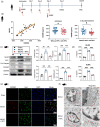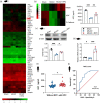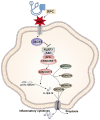Remote limb ischemic postconditioning inhibits microglia pyroptosis by modulating HGF after acute ischemia stroke
- PMID: 38023701
- PMCID: PMC10658568
- DOI: 10.1002/btm2.10590
Remote limb ischemic postconditioning inhibits microglia pyroptosis by modulating HGF after acute ischemia stroke
Abstract
The repetitive inflation-deflation of a blood pressure cuff on a limb is known as remote limb ischemic postconditioning (RIPostC). It prevents brain damage induced by acute ischemia stroke (AIS). Pyroptosis, executed by the pore-forming protein gasdermin D (GSDMD), is a type of regulated cell death triggered by proinflammatory signals. It contributes to the pathogenesis of ischemic brain injury. However, the effects of RIPostC on pyroptosis following AIS remain largely unknown. In our study, linear correlation analysis confirmed that serum GSDMD levels in AIS patients upon admission were positively correlated with NIHSS scores. RIPostC treatment significantly reduced GSDMD level compared with patients without RIPostC at 3 days post-treatment. Besides, middle cerebral artery occlusion (MCAO) surgery was performed on C57BL/6 male mice and RIPostC was induced immediately after MCAO. We found that RIPostC suppressed the activation of NLRP3 inflammasome to reduce the maturation of GSDMD, leading to decreased pyroptosis in microglia after AIS. Hepatocyte growth factor (HGF) was identified using the high throughput screening. Importantly, HGF siRNA, exogenous HGF, and ISG15 siRNA were used to reveal that HGF/ISG15 is a possible mechanism of RIPostC regulation in vivo and in vitro.
Keywords: acute ischemic stroke; high throughput screening; microglial; pyroptosis; remote limb ischemic postconditioning.
© 2023 The Authors. Bioengineering & Translational Medicine published by Wiley Periodicals LLC on behalf of American Institute of Chemical Engineers.
Conflict of interest statement
The authors declare no competing interests.
Figures






References
-
- Feigin V, Roth G, Naghavi M, et al. Global burden of stroke and risk factors in 188 countries, during 1990–2013: a systematic analysis for the global burden of disease study 2013. Lancet Neurol. 2016;15(9):913‐924. - PubMed
-
- Walter K. What is acute ischemic stroke? JAMA. 2022;327(9):885. - PubMed
-
- Jovin T, Nogueira R, Lansberg M, et al. Thrombectomy for anterior circulation stroke beyond 6 h from time last known well (AURORA): a systematic review and individual patient data meta‐analysis. Lancet (London, England). 2022;399(10321):249‐258. - PubMed
LinkOut - more resources
Full Text Sources
Miscellaneous

